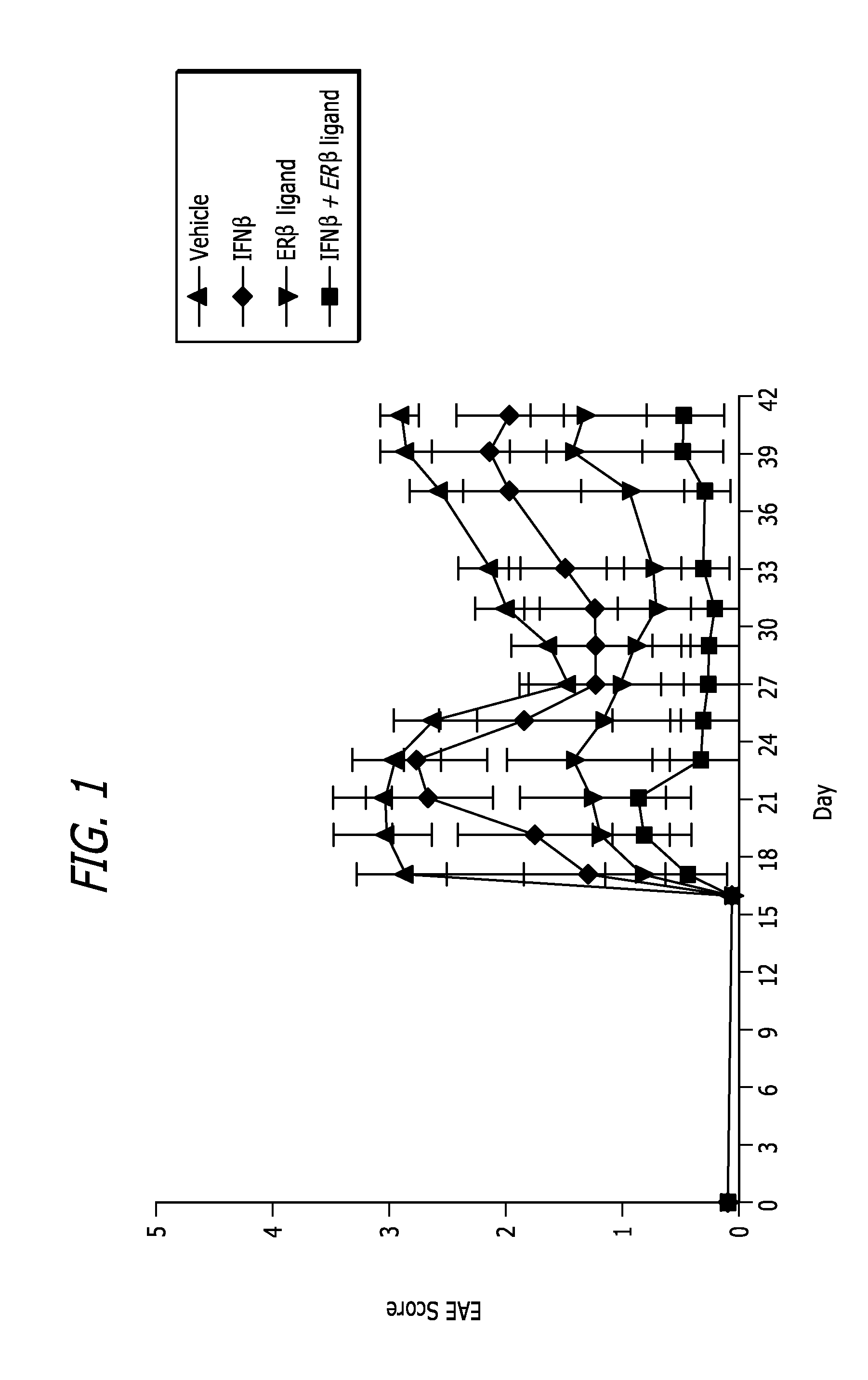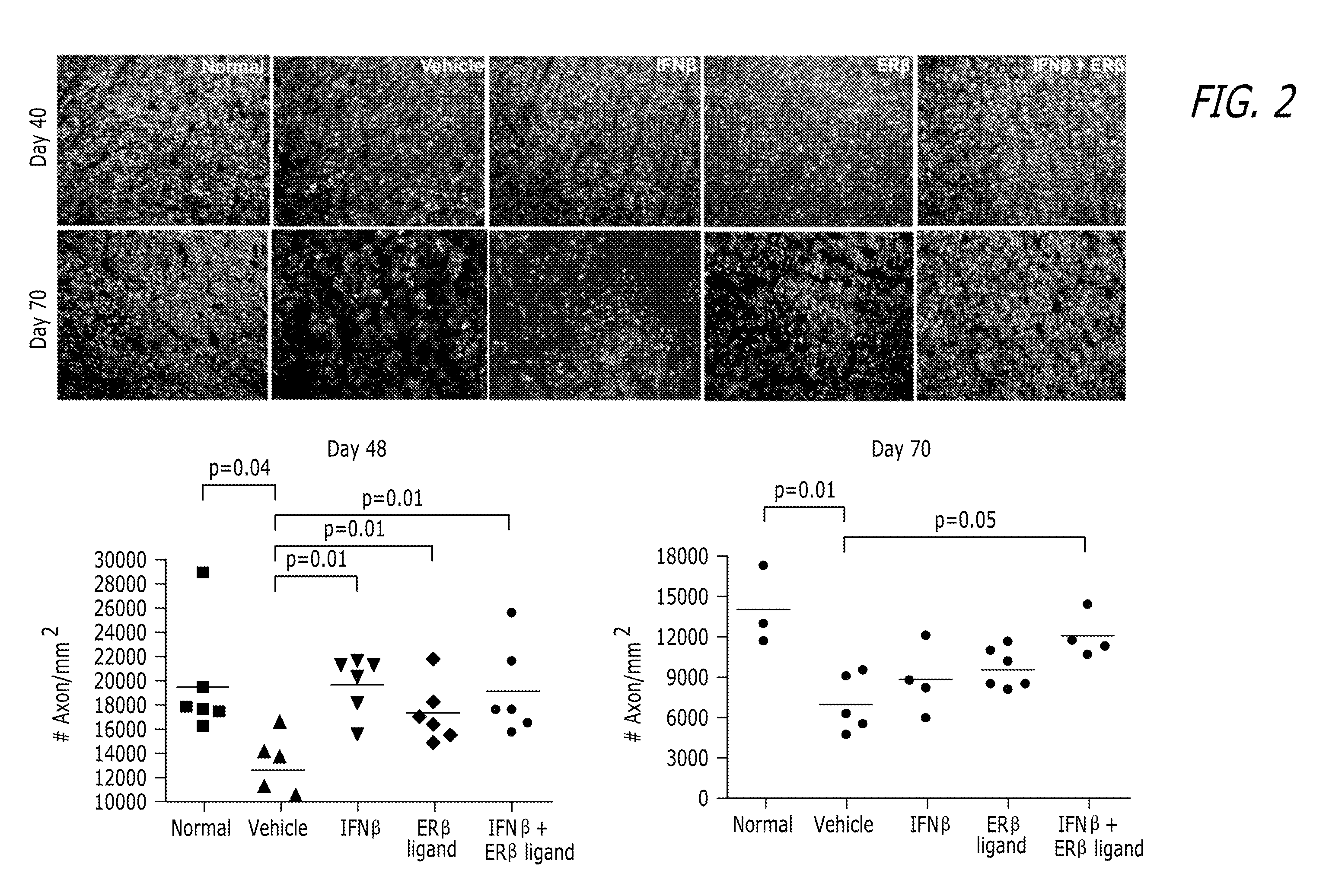Estrogen receptor ligand and/or interferon beta treatment for neurodegenerative diseases
a neurodegenerative disease and interferon beta technology, applied in the field of estrogen receptor ligand and/or interferon beta treatment for neurodegenerative diseases, can solve the problems of incomplete myelination in experimental autoimmune encephalomyelitis (eae), the animal model of multiple sclerosis (ms), and current anti-inflammatory or immunomodulatory treatments, which are partially effective, and have only modest to minimal effects on the development of neurodegeneration and clinical disability in the secondary progressiv
- Summary
- Abstract
- Description
- Claims
- Application Information
AI Technical Summary
Benefits of technology
Problems solved by technology
Method used
Image
Examples
example 1
[0062]Material and Methods: Animals: B6.Cg-Tg (Thy1-YFP) 16Jrs / J (Thy1-YFP) mice 8-10 weeks old were purchased from the Jackson Laboratory (Bar Harbor, Me.). Animals were maintained under environmentally controlled conditions in a 12 hour light / dark cycle with access to food and water ad libitum. All procedures involving animals were carried out in accordance to the NIH guidelines for the care and use of laboratory animals and approved by the UCLA Chancellor's Animal Research Committee and Division of Laboratory Animals Medicine.
[0063]Reagents: The ERβ ligand Diarylproprionitrile (DPN) was purchased from Tocris Biosciences (Ellisville, Mo.) and dissolved with molecular grade ethanol purchased from EM Sciences (Hatfield, Pa.). Miglylol 812N liquid oil was Sasol North America (Houston, Tex.). Recombinant mouse Interferon-beta (IFNβ) was purchased from PBL InterferonSource (Piscataway, N.J.). All reagents were prepared and stored according to manufacturer's instructions.
[0064]EAE induc...
example 2
[0094]Methods: Animals: Breeding pairs of PLP_EGFP mice on the C57BL / 6J background were a kind gift from Dr. Wendy Macklin (University of Colorado, Denver). The generation, characterization and genotyping of PLP_EGFP transgenic mice have been previously reported. Mice were bred in house at the University of California, Los Angeles animal facility. All procedures were conducted in accordance with the National Institutes of Health (NIH) and were approved by the Animal Care and Use Committee of the Institutional Guide for the Care and Use of Laboratory Animals at UCLA.
[0095]Reagents: Diarylpropionitrile (DPN) was purchased from Tocris Bioscience (Ellisville, Mo.). Miglyol 812 N liquid oil was obtained from Sasol North America (Houston, Tex.). MOG peptide, amino acids 35-55, was synthesized to >98% purity by Mimotopes (Clayton, Victoria, Australia).
[0096]Hormone Manipulations: Female mice (6 weeks old) were ovariectomized two weeks prior to induction of EAE. Ovariectomized mice were tre...
PUM
| Property | Measurement | Unit |
|---|---|---|
| volume | aaaaa | aaaaa |
| thick | aaaaa | aaaaa |
| adhesion | aaaaa | aaaaa |
Abstract
Description
Claims
Application Information
 Login to View More
Login to View More - R&D
- Intellectual Property
- Life Sciences
- Materials
- Tech Scout
- Unparalleled Data Quality
- Higher Quality Content
- 60% Fewer Hallucinations
Browse by: Latest US Patents, China's latest patents, Technical Efficacy Thesaurus, Application Domain, Technology Topic, Popular Technical Reports.
© 2025 PatSnap. All rights reserved.Legal|Privacy policy|Modern Slavery Act Transparency Statement|Sitemap|About US| Contact US: help@patsnap.com



